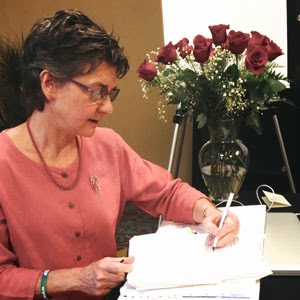In my outside-of work life, I am the mother of a child with a rare disease. I recently volunteered to chair the Board of Directors of the international patient group. My involvement with leading this group as it approaches a clinical trial has taught me a considerable amount about research-in-action and the importance of collaborative partnerships – two themes of high relevance to our Center.
The disease is an ultra-rare, catastrophic genetic condition called Fibrodysplasia Ossificans Progressiva (FOP). FOP causes bone to grow in skeletal muscles, creating a second skeleton that freezes joints and prevents movement. There are fewer than 900 known cases of FOP in the world.
Marilyn at a recent IFOPA meeting.
The patient group is the International FOP Association or IFOPA, founded in 1988. Medical research in FOP has increased dramatically since the patients organized, and what is understood about the condition has progressed greatly. The most important discovery so far happened in 2006 when researchers at the University of Pennsylvania identified the FOP gene. Since the gene discovery, attention from researchers and, recently, from pharmaceutical companies, has grown exponentially, and along with it, our need to navigate across stakeholder groups.
To collaborate is to work jointly on an activity to produce something or work towards a shared goal. The collaboration of patients, researchers, and pharmaceutical companies fits that definition, but it is not exactly a group project where everyone has the same goal. These stakeholders have different perspectives, and although they are all working on a treatment for FOP, their goals and motivations differ:
- FOP patients want a treatment for their disease, and something to allow rehabilitation from damage already done. Patients are in a race against time because FOP is progressive.
- The patient group, the IFOPA, wants to encourage drug development by contributing natural history data to document the natural course of FOP, collecting patient data, and encouraging its members to participate in clinical trials. Data collected in one international registry and owned by the IFOPA would let the patient group control the data and share it with research and pharmaceutical stakeholders.
- Researchers want their work to lead to discovery: A gene, a disease mechanism, a drug candidate. Researchers need publications and grants. Since they compete with other researchers, they also want to protect their data, which can be an unfortunate barrier to collaboration.
- Pharmaceutical companies want a product. They want successful clinical trials, regulator approval, and a useful drug. In rare disease research, pharmaceuticals want a wider audience to buy the drug, to meet their ultimate goal of making a profit. The pharmaceutical companies working on FOP hope their drugs will also help non-genetic conditions of bone growth that comes up after hip and knee replacements, spinal cord injuries, stroke, atherosclerosis, closed head injuries, and heart valve replacement surgeries.
Despite their different perspectives, we stakeholders need each other. Only through collaboration will we be able to reach the goal of finding a treatment for FOP.


